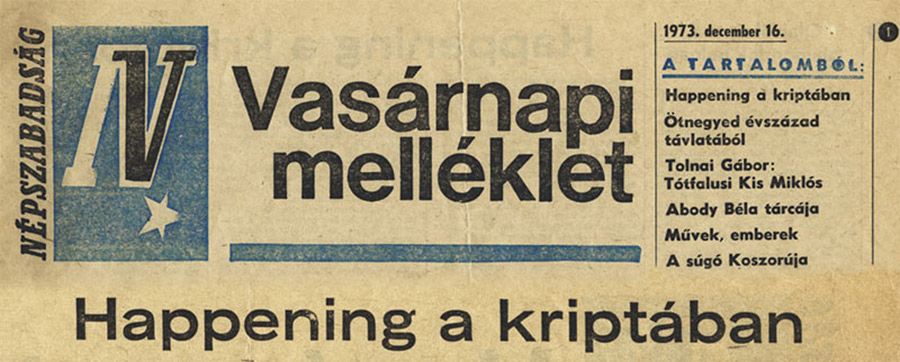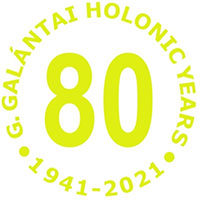Gyula Kozák (H)
GALÁNTAI 80
This being-the-same-age business bothers me! In the past, whenever I wrote a laudation about someone, there were at least twenty years, but more like 30-40 years age difference between me and the lauded individual. Let’s say I was 35 and the given person was 80. It was an easy job. Our lives only slightly overlapped, and indeed, the lauded person’s life was virtually history for me. My interpretation was either correct or not, but even in the latter case, I was forgiven easily, if for no other reason than because of my age. In Gyuri Galántai’s case it is entirely different. First of all, we are the same age. He is 80, and so am I. We lived through the same history. There no room for inaccuracy or prevarication. Especially since I’ve known the one we are celebrating since college years, i.e. for roughly 60 years. No, our lives were not intertwined; there were only occasional periods, sometimes short, sometimes longer, when our lives ran parallel, but there was no time during the six decades when I didn’t know what was going on with Gyuri, either in his public or private life. I knew when he got married, that he and his wife founded Artpool, they had children together, he was on a scholarship abroad, Bucuska [Ottilia Solt's daughter] was babysitting for them, he rented the chapel [in Balatonboglár] and then it was closed down by the authorities, that AL was launched, he moved, he had an exhibition venue, and after the unfortunate episode called the democratic turn I thought his time had come, he would soon become an academic and Artpool’s pockets would be lined with money, he would be given the chapel at Balatonboglár as a bonus and the only reason a street wouldn’t be named after him is because no street is named after people who are still alive. I was wrong about the latter half. It’s true that he was (would have been) allowed to use as many rubber stamps without being fined as possible, but his life of trials and tribulations continued. Except, this time, The autorities ara not bothered. And now, at the age of 80, we can say his boat has come in.
György Galántai’s most amazing quality is that he was spot on about things even in their retrospective historical context. Let me explain. He became a leading figure of the Hungarian underground scene early, very early on. And he was never wrong. He never ‘struck deals’ with anyone (artists, art historians, politicians, members of the opposition), never organized an exhibition, affiliate himself with anyone and include anyone in his Artpool Letter who would have later betrayed him and shifted to the other side. None of the authors in AL and none of the Hungarian artists featured in it boogied their way into some profitable job; on the contrary, they did or are still doing what they did in 1960, in 1970 and 1980, acting against the mainstream, risking their livelihoods. The repertorium of AL provides factual proof of this. I do not wish to mention specific people as examples lest I hurt those left out. I will make two exceptions though, because they are sadly no longer with us. Ákos Birkás and Miklós Erdély were frequent contributors in AL as well as in Gyuri’s life and activities.
I don’t know how György Galántai is summed up in an encyclopaedia entry, and now, while I’m writing these lines, I won’t check it. For me he was the world’s bravest arts organizer, the most entertaining sculptor (see his creations made from factory waste), a teacher who shaped people’s personalities in a big way (along with Miklós Erdély and Dóra Maurer), the publisher of the most topical fine art periodical of his time, the one who introduced the artistamp to Hungary and raised awareness of it, the man who propagated his fellow artists he deemed deserving of such, the multifunctional user of the chapel in Balatonboglár, the organizer of exhibitions and the performances of Halász’s theatre in Balatonboglár and, at the end of the day, the greatest Hungarian rubberstamper and rubberstamp-maker, etc. I don’t need to talk about Artpool since it is a historic achievement that has secured a place for Gyuri and Juli – who has been Gyuri’s companion for life as long as I remember.
The chapel in Balatonboglár as well as the exhibitions and theatre performances held there have preoccupied many authors and have been the subject of many pieces of writing. Those years in the middle of the Kádár era were truly wonderful. It is a miracle in itself that it was allowed to exist for even a minute and that on the first day: when people appeared (we appeared) as dishevelled ‘hooligans’ in sandals and no socks, with the only sports bag brand available at the time on our shoulders, with long hair, sloppy, having hitched our rides, we should’ve been first taken to the local police station and from there to the county police headquarters, from where we should’ve been flung into sweatboxes and driven to Budapest, to the facility in Bérkocsis Street, and Gyuri Galántai should’ve been taken into custody for a few years and sentenced to another 3-4. But that is not what happened! The dilapidated, up to then unused chapel was transformed into an exhibition venue, what’s more into a theatre and concert hall for a brief period, and it took many years of and a great many reports by [secret agent] Algol before the authorities managed to remove Gyuri, who was obstructing the building of socialism.
This was the beginning of the invitation of the 1973 summer events. Please note that Gyuri first addressed the potential guests in Russian. This of course can be seen as ironic but he definitely did his best. He adapted to the ‘spirit of the age’. In his own ironic way.

This was followed by a list of names that any auction house would be proudly showing off today. Moreover, besides the painters and sculptors, the chapel was frequented by poets, singers, musicians and art historians, and of course entire troupes too. Since only summer was suitable to mount exhibitions here, the season lasted from June to September.
The season of 1973 opened with Júlia Vajda’s exhibition. Júlia Vajda was generous and said that there was enough space for a few Jakovits sculptures in the chapel besides her works, and there it was, Gyuri exhibited some sculptures by Júlia Vajda’s husband, at the time having lived in America for eight years. Júlia’s altruism didn’t stop here. She squeezed some pictures by her friend, Renée Kelemen, who was a member of the great clan, in-between her own works. Gyuri was agreeable to this too, although he originally wanted to mount a show only (only?) of Júlia Vajda’s art.
Júlia was drawing and doodling, was happy about the exhibition, and she inserted the place and time of the joyous event in-between two small drawings, neither of which she intended as artworks. Gyuri snatched this ‘creation’ and reproduced it to use it as the invitation for the exhibition. The printed invitation obviously contained the usual text.

And below is the really non-conformist, unique invitation reproduced by print and sent to friends and acquaintances; a copy of it is on file at the ministry of internal affairs.

This semi-legal exhibition was very important for Júlia Vajda. Firstly, because this is how Gyuri Galántai integrated her into the mainstream, contemporary young artists, and secondly because the artists of the European School were not given the opportunity by the communist regime to have solo shows, only occasional group exhibitions at best.
Success had a very different meaning in Balatonboglár than it did for example in Műcsarnok and the Csók István Gallery in Budapest. A lot of us went to the opening and then had a great time in a restaurant celebrating Júlia. In this photo you can see Endre Bálint, Stefánia Mándy, Béla Tábor in half profile, Iri [Irina] – who was Júlia’s sister and Bálint’s wife – with her back to us, and Éva Barta. A table wasn’t enough for the whole company, so we occupied the whole terrace of the café, and were happy. Júlia was with us, and she was also happy.

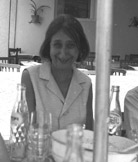
Júlia Vajda in Balatonboglár
Everything was great, everything was fine, and the Júlia Vajda exhibition was followed by others, as well as by Péter Halász’s theatre performances, evenings of poetry, musical evenings and even more fine art exhibitions, as Gyuri was relentlessly organizing the chapel events. And then, on 16 December 1973, the most unscrupulous journalist of the party paper, Népszabadság [transliterates into ‘people’s freedom’], or rather the party’s serviceman, published a foudroyant article condemning the chapel in Boglár as well as its renter and operator, Gyuri Galántai.
Júlia Vajda, who was a reserved and quiet person, was upset that Galántai and his remarkable chapel project were being abused. At the time Péter Halász’s performances had been on along with many exhibitions, and Júlia dictated her letter addressed to Népszabadság’s editor-in-chief to her daughter, and posted it straight away at post office number 72, which is no longer there. The commentary which she added to her letter when sharing it with her close family had a far sharper tone than the letter itself. “So what if these sweet young people made love on starry nights? Why does it ail this scoundrel?” (This scoundrel was László Szabó...)
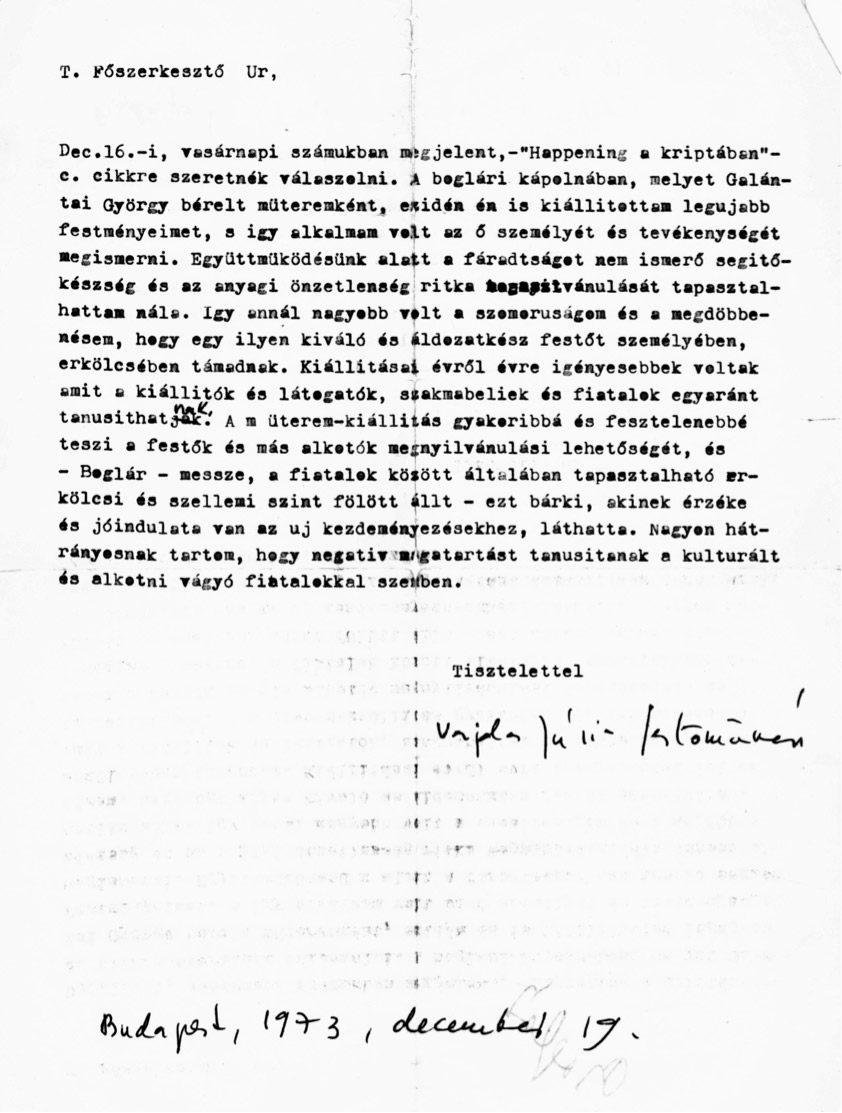
Budapest, 19 December 1973
Dear Editor-in-chief,
I want to respond to the article titled “Happening in the Crypt”, which you published in the Sunday issue of your daily on 16 December. This year I also exhibited my latest pictures in the chapel in Boglár, which György Galántai rented as a studio, which gave me the opportunity to get to know him as a person and his activities. During our project I experienced a kind of helpfulness and financial generosity from him that is rarely seen, so my sadness and shock couldn’t have been greater upon seeing how the personality and morality of such an excellent and selfless painter were under attack. His exhibitions were of a better and better quality every year, which will be confirmed by the exhibitors, visitors, people in our profession and the young people who were there. Studio exhibitions help painters and other artists to express themselves more often and more freely, and Boglár’s moral and spiritual standards were far above those typical among young people in general – this could be seen by anyone who has a talent and openness to new initiatives. I regard it as highly disadvantageous that you take a negative attitude to cultured young people who want to do something creative.
Yours sincerely,
Júlia Vajda, painter
I no longer remember how many times I went down to Balatonboglár. Back then I still had a job, an income, and travelling by train was cheap. Sometimes I stayed down there, although not under the starry sky but in the chapel, where some of us talked and discussed things, mostly with the artists whose exhibitions had just opened. I had the opportunity to get to know fantastic people, those who are already at the front line of the official fine art canon in Hungary. Gyuri’s sense for spotting quality – in artists and in people in general – has remained deadly accurate all his life. No wonder he chose Juli as his wife and companion in his life beset with difficulties.
HAPPY BIRTHDAY ON YOUR EIGHTIETH!

● COURAGE ● euronews ● The Regime Will Change ● HUNGARIAN SPECTRUM ●
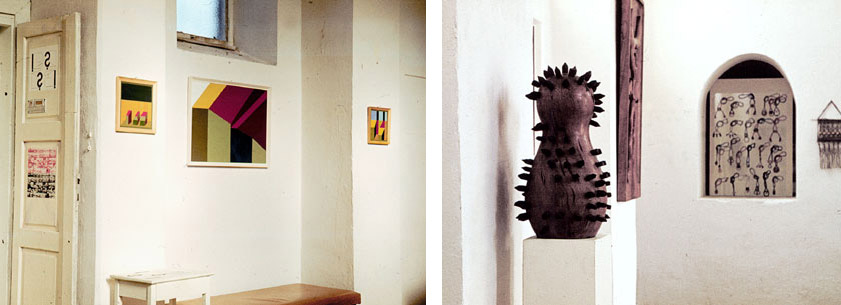
Exhibition enterieur: paintings by Júlia Vajda Works by József Jakovits and Renée Kelemen
● 10-16 June 1973. - The exhibition of Júlia Vajda ●

